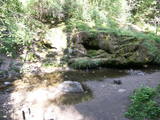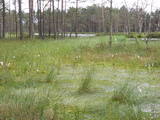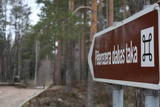| Nr | Nosaukums | Apraksts |
|---|---|---|
|
Salaca no ūdenstūrisma viedokļa ir interesanta upe, kurā pat mazūdens periodā priecēs krastā esošās ainavas un apskates objekti, kā arī pašas upes daudzveidība. Laivošanai pievilcīgākā ir Mazsalacas apkaime un Mērnieku – Vecsalacas posms, kur kartē redzami vietvārdi, kas saistīti ar tačiem. Tači – bijušās nēģu ķeršanas vietas ir tā unikalitāte, kas raksturīga tikai Salacai upes posmā lejpus Iģes ietekas. Mūsdienās par taču kādreizējo esamību liecina vietvārdi – Ģedertu tacis, Žvīguļu tacis u.c. Nēģu tačus būvēja vietās, kur upe ir seklāka, šaurāka, ar salām un straujtecēm bagātāka, tādēļ vietvārds „tacis” nozīmē arī interesantākus laivošanas apstākļus. Paši tači ir saglabājušies tikai upes lejtecē pie Salacgrīvas. Nakšņošana g.k. ūdenstūristu apmetnēs (teltīs). Maršruts atrodas Ziemeļvidzemes biosfēras rezervātā. Maršruta informācija no Latvijas Lauku foruma |
||
|
Raunas Staburags pēc Daugavas Staburaga appludināšanas šobrīd ir Latvijā raksturīgākais un izteiktākais šūnakmens veidojums, kas ir ~ 8000 gadus vecs un turpina veidoties arī mūsdienās - uz sūnām u.c. augiem izgulsnējoties avotkaļķiem. Raunas Staburags minēts kā vienīgā Alpu kreimules atradnes vieta, taču pēdējo 15 gadu laikā minētā suga nav konstatēta. Domājams, ka iemesls tam ir Staburaga apmeklētāju intensīvais nomīdījums. Avoti, kas veido avotkaļķus ir ES nozīmes prioritāras aizsardzības biotops. Tā kā Raunas Staburags šobrīd ir tā apmeklētāju nobrādāšanas un citu nedraudzīgu rīcību ziņā viens no visvairāk postītiem un apdraudētākajiem Latvijas dabas objektiem, skatīsimies to tikai no pretējā krasta un izbaudīsim "ar acīm" un fotoaparāta palīdzību!
|
||
|
Priekules luterāņu baznīca celta baronu laikos ap 1680. gadu. 1792. gadā tā piedzīvojusi jaunu pārbūvi un ieguvusi tagadējo izskatu. No 2005. gada 6. augusta visiem interesentiem ir pieejams baznīcas skatu tornis, no kura savulaik savu vēsturisko lidojumu ir sācis leģendārais Priekules Ikars. Baznīcas tornī Sakrālā tūrisma projekta ietvaros ir ierīkotas savdabīgas kāpnes, par kurām uzkāpjot torņa smailē kaut nedaudz iejutīsieties Ikara lomā un aplūkosiet pilsētu no augšas. |
||
|
Pērnavas viduslaiku nocietinājumu mūra stūra tornis. Tā pagalms – populāra suvenīru tirdzniecības un pasākumu norises vieta. |
||
|
Ap 2 km garā taka izveidota 1994. g. No autostāvlaukuma tā uzlīkumo Daugavas ielejas krastā, kur mežu ieskauts ieslēpies viens no mazākajiem latgaļu pilskalniem. Tā dienviddaļu noraka 20. gs. 20. gados, kad te ieguva granti. Pilskalna plakums atrodas ~ 40 m virs Daugavas līmeņa, tādēļ pa nelielo skatu stigu vērojama iespaidīga Daugavas ielejas ainava. Takas malā netālu no Putānu strauta ir redzams stabs, kas iezīmē projektētā Daugavpils HES maksimālā ūdenslīmeņa atzīmi. Tālākajā gaitā taka aizved līdz Slutišku sādžai. |
||
|
Parka nozīmīgākās dabas vērtības ir viens no bagātākajiem Latvijas putnu ezeriem, tā apkaimes augu valsts un Rīgas līča seklūdeņi.
|
||
|
Kafejnīca "Express Pizza" atrodas tirdzniecības centrā „Oga”, izbraucot no Preiļiem Līvānu virzienā. Piedāvā sierus, kas ir pilsētas „vizītkarte”. Kafejnīcā ir divas ēdināšanas zonas ar kopēju ēdamzāli: vienā zonā latviešu tradicionālie ēdieni un kūkas, otrā – picas. Latviešu virtuve: „Preiļu kļockas”, „Preiļu siera zupa” un siera kūka. |
||
|
Akmeņupīte, kas traucas lejā no Augšzemes augstienes uz Dvieti un tālāk – Daugavu straujo tecējumu var novērot tikai pavasaros vai pēc lietavām. Pārējā laikā tā ir sekla upīte ar akmeņainu gultni. Upītes krastos ir izveidota jauka taka ar vairākām atpūtas un ugunskura vietām (ir malka), bet slāpes var veldzēt no avotiem.
|
||
|
Viens no lielākajiem Latvijas purvu masīviem starp Babītes ezeru un Olaini, kura lielākā daļa ir un joprojām tiek izstrādāta kūdrā. Relatīvi maszkarta ir purva ziemeļu daļa, kurā izveidojies izcils purva ezeriņu komplekss un sūnu purva ainavas. Cenas tīrelis ir arī viens no retajiem Latvijas purviem, kurā vienlaikus ir novērojama gan rietumu, gan austrumu tipa purva ainava. Nozīmīga vairāku aizsargājamu putnu sugu dzīves vieta. Cenas tīrelī 2007. g. ir izveidota dabas taka un skatu tornis.
|
||
|
Maizes ceptuve "Liepkalni" atrodas Daugavas krastā starp Stukmaņiem un Pļaviņām. Apvieno ceptuvi, veikalu un kafejnīcu. "Liepkalnu" sortimentā ir vairāki desmiti maizes veidi, cepumi, tortes, kūkas un smalkmaizītes, kvass. Pie ceptuves var izbraukt ar Vikingu kuģi pa Daugavu. “Liepkalnu” maize tiek cepta piecās ceptuvēs Latvijā - Vidzemes reģionā Rūjienā, Valmierā, “Liepsalās” un Ķekavas pag., "Džutas", t/c A7 .
|
||
|
Baltijas valstīs lielākā dzintara ekspozīcija (no 1963. g.) ar augu, kukaiņu u.c. ieslēgumiem. Atspoguļota tā nozīme Baltijas tautu vēsturē. Muzejs iekārtots grāfam Fēliksam Tiškevičam (1865. – 1932.) piederošajā pilī (uzcelta 1897. g.). |
||
|
Tērvetes vīni ir ģimenes vīna darītava Tērvetē. Ražojam vīnu no pašu audzētām ogām un augļiem – avenēm, āboliem, ķiršiem, ērkšķogām, upenēm, cidonijām un no “īpašā dārzeņa” – rabarbera! 2019. gadā esam uzsākuši arī sava vīnogu dārza veidošanu un plānojam piedāvāt saviem viesiem vīnogu vīnu. Mēs - Dace un Sandris Laizāni, Tērvetes vīnu saimnieki esam kaislīgi “vīna mīļi” un šo mīlestību pret vīnu vēlamies nodot arī mūsu viesiem! Jums piedāvājam vīna darītavas apskati un vīnu degustāciju ar omulīgām sarunām par vīna tapšanu jaukā lauku ainavā Tērvetes upes krastā. Atkarībā no sezonas piedāvājam dažādu augļu un ogu vīnu, dzirkstošo vīnu un brendiju degustāciju. Saimniece Dace arī palutinās Jūs ar nelielām uzkodām - mājās ceptu maizi un pašas sietu sieru. |
||
|
Izejot lokveida taku, apmeklētāji iepazīs unikālo kangaru (paralēlas vaļņveida kāpas) un vigu (starpkāpu ieplakas ar zāļu purviem) ainavu – iepriekšējo Baltijas jūras ģeoloģisko stadiju lieciniekus, kā arī augstā tipa purvu (Pēterezera purvs) un vecā šaursliežu dzelzceļa paliekas. Purvā un mitrajās vietās izveidotas koka laipas. Taka atrodas Slīteres nacionālā parka teritorijā. Takas garums ir 3,5 km, kas veidojusies pirms ~ 6000 gadiem, jūrai atkāpjoties. |
||
|
This is for people who enjoy forests, wildlife, local traditions and has a specific interest in the different species of funghi. Everyone could try their hand at mushrooming, identification and by the end of the day together with guide sort out the collected mushrooms. The tour passes several national parks and late back villages. The group will also visit to one of shitake mushroom growers for comparison reasons. |
||
|
Neskartu mežu cienītāji var doties izpētīt Plakanciema puses mežu takas. Braucot no Plakanciema pasta nodaļas Mellupu virzienā pa autoceļu V7, pēc aptuveni 1 km jānogriežas ceļā pa labi. Tālāk jādodas uz priekšu vēl 1,2 km. Maršruta sākums - iepretī mājām “Putriņas” ceļa kreisajā pusē, kur sākas meža ceļš. Sākumā maršruts ved pa taisnu meža ceļu. Pēc 500 m nonākam pie ūdenskrātuves (karjera). Šeit ir iespēja doties vai nu gar vienu ūdenskrātuves krastu, vai gar otru. Abās pusēs var aiziet aptuveni līdz ūdenskrātuves pusei un tad griezties atpakaļ. Krastā augošos kokus iecienījuši bebri. Ūdenī peldas pīles, meža ceļa malā vairāki skudrupūžņi, no sakritušo pērno lapu apakšas lien ārā zaķskābenes. |
||
|
Celta pirmās Latvijas brīvvalsts laikā. Meklējama Tukuma ielā 30. Laikā no 1940. gada pastā darbojās automātiskā telefonu centrāle. Pasts vairs nestrādā un ēka apskatāma no ārpuses. |
||
|
Atrodas 1,2 km dienvidos no Ģipkas centra, otrpus Jūrmalas – Kolkas ceļam (P 131). Grūti noticēt, ka tagad redzamā un no laukakmeņiem būvētā baznīca ir tapusi pavisam nesen – pēc 1992. gada, jo iepriekšējā nodega padomju laikā – 1979. g. Ironisks ir apstāklis, ka baznīcas tornī pēc 2. pasaules kara atradās Dundagas mežniecības uguns novērošanas postenis. Ugunsgrēka laikā gāja bojā greznais altāris un ērģeles, taču altārgleznu „Kristus pie krusta” izglāba. Tagad dievnams atkal kalpo savam pamatmērķim. |
||
|
Atrodas pie viena no populārākajiem Kurzemes tūrisma objektiem – Ventas rumbas un Vecā ķieģeļu tilta pār Ventu. Blakus stāvlaukums ar lielisku Kuldīgas ainavu, blakus spēļu laukums, atpūtas vieta. Piedāvā maltītes visām ēdienreizēm. |
||
|
Kafejnīca Ugandi ir mājīga vieta pašā Otepää sirdī, kur valda silta gaisotne, patīkamas noskaņas un garšas ir tīras un tīkamas. Ierodoties tūliņ sajutīsiet kvalitatīvas kafijas un saldu maizīšu smaržu. Lielā vitrīna ir pilna gardām kūkām – tās var baudīt gan uz vietas, gan iegādāties līdzņemšanai. |
||
|
Atrodas Inciema centrā. Piedāvā maltīti visām ēdienreizēm. Lielas porcijas, garšīgs ēdiens. Iecienīta tuvākas un plašākas apkaimes maltītes ieturēšanas vieta. Klāj galdus. |
||






















